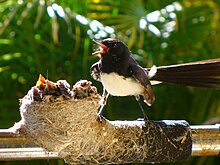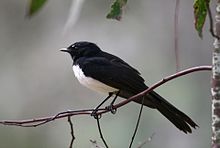Garden fan tail
| Garden fan tail | ||||||||||||
|---|---|---|---|---|---|---|---|---|---|---|---|---|

Garden fan tail |
||||||||||||
| Systematics | ||||||||||||
|
||||||||||||
| Scientific name | ||||||||||||
| Rhipidura leucophrys | ||||||||||||
| ( Latham , 1802) |
The garden fan tail ( Rhipidura leucophrys ) is a songbird from the fan tail family (Rhipiduridae). In Australia, the species is one of the best-known and most common birds. Due to its noticeable tail movements, it is called Willie Wagtail (Willie wiggle tail) in English usage .
The stocks are considered not endangered in its entire range. In Australia, its populations have increased after European colonization, as it finds a greater food supply due to the deforestation of forests and the expansion of agricultural land.
features
The garden fan tail, which is around 20 cm long, weighs around 18 grams. Adult birds have a black head with a white stripe across the eyes . The neck and top of the body are also black. In good lighting conditions, the top of the body shines slightly. The tail plumage is dark brown and the underside of the body is white except for the black chin and the black throat.
Young birds are not jet black on the upper side, but rather dark gray, their wing tips are brownish. His singing, which is sometimes melodically chirping, but interspersed with rhythmic-mechanical sounding elements, is mainly performed at night.
Possible confusion
The garden fan tail is usually easy to identify. However, there are two types among the monarchs that superficially resemble him. The white-throated monarch ( Myiagra inquieta ) has no black head; his chin and throat are white. The silk monarch ( Myiagra cyanoleuca ) is significantly smaller than the garden fan tail, has a shorter tail plumage and a small, openable feather hood.
distribution
The distribution area of the garden fan tail includes large parts of Australia , the Solomon Islands , the Bismarck Archipelago , the Moluccas and large areas of New Guinea . In Australia, the garden fan tail is only absent in the far north of the Cape York Peninsula and a larger area in Western Australia . In the Torres Strait , the approximately 185 km wide strait between the northeast Australian Cape York Peninsula and the south coast of New Guinea, the garden fan tail occurs only on three islands. In Tasmania it is an occasional stray visitor in the north, so far there is only one brood specimen for this island. Even on the Chatham Islands and Lord Howe Island , the garden fan tail is only an occasional wanderer.
The garden fan tail populates a number of very different habitats. It is basically a bird of open, only sparsely forested landscapes and also occurs on grassland. In arid and semi-arid regions it is usually found near bodies of water. It is also found in parks, gardens, golf courses and on agricultural land.
The garden fan tail is a resident bird in most of its distribution area , which according to current knowledge defends a territory all year round. The rediscoveries of ringed birds also point to local loyalty. The majority of the recovered birds have moved no further than 10 kilometers from the original ringing location. Seasonal population increases in individual regions can be attributed to the dispersion of young birds and local migratory movements after the breeding season.
Subspecies and their distribution
The following subspecies are distinguished;
- R. l. melaleuca (Quoy & Gaimard, 1830) - Moluccas and western New Guinea and adjacent islands, Aru Islands, Bismarck Archipelago, and Solomon Islands.
- R. l. picata Gould, 1848 - North of Australian from Kimberley in Western Australia via the north of the Northern Territory to the north of Queensland.
- R. l. leucophrys (Latham, 1801) - South Australia and Kangaroo Island.
behavior
The birds can usually be found alone or in pairs. Outside of the breeding season, however, they form larger flocks, sometimes with other bird species. The food consists of small invertebrates that the garden fan tail looks for on the ground. He moves the fanned tail back and forth conspicuously. The bird is often found near herds of cattle to catch frightened insects. The animals are also used as a seat guard, from which insects are captured in flight.
Reproduction
Couple relationship and territory
Fan tails are monogamous, the couple relationship probably lasts for more than one breeding season. Both birds in a pair indicate the boundaries of their territory by singing and both vigorously defend their breeding territory, with their behavior during the breeding season being significantly more aggressive than outside the breeding season. Outside the breeding season, the area is only defended against conspecifics. During the breeding season, garden fan tails show aggressive behavior towards other bird species regardless of their size. For example, such large birds as the wedge-tailed eagle , hunter's lair , black-faced caterpillar catcher and flute bird , which are potential predators of nestlings, are attacked. Garden fan tails also show aggressive behavior towards very small species that are harmless to eggs and nestlings, such as gray-coated goggles ( Zosterops lateralis ) and gray fan tails . However, humans, dogs and cats are also attacked when they come near the nest.
Breeding season, nest and clutch
The breeding season in Australia is usually between August and February, but clutches can be found in the breeding areas near the equator throughout the year. The garden fan tail builds a neat, bowl-shaped nest made of grass and cobwebs on branches, masts or roofs, which is padded with hair. The bird sometimes plucks these directly from animals. Nests are often used multiple times; old nests serve as building material for new ones.
The clutch usually consists of three cream-colored eggs with gray or brown spots, which both adult birds incubate for around two weeks. During the night, the non-breeding parent bird rests near the nest. After 14 days, the young fledglings, which are fed by both parent birds. Fledglings that have fledged initially seek cover near the nest and only leave it to be fed by the parent birds. In one breeding season, the pairs can breed up to four times. The broods can overlap: One of the two parent birds is already incubating the next clutch, while the other parent bird provides the young birds with food.
Fledglings fledged
Young birds are fed with food for around two weeks after they have fledged. The amount of food offered decreases significantly towards the end of the second week. The young birds are then no longer tolerated in the breeding area of the parent birds, but are attacked. The period between the point in time from which the young birds have to find their food independently and the moment from which the parent birds try to drive the young birds out of the territory varies depending on the respective habitat. In garden fan tails, which have been observed for a longer period in Sydney, the young birds are increasingly dependent on their own foraging from the 12th day after leaving the nest. From the 17th day after leaving, they no longer receive any food from their parent birds. From the 19th day the parents begin to show aggression towards their offspring. They are tolerated longer in the breeding area of the parent birds if they do not raise any more broods or the clutch has been lost by predators or the like. In the case of garden fan tails, the reproductive biology of which was examined in more detail in Adelaide, the parent birds tolerated the young birds in the territory for 24 days.
Life expectancy
On the basis of ringing finds it was possible to prove that garden fan tails can live for several years. A fan tail ringed as an adult bird was found nine years and four months later.
Trivia
Around 1923 attempts were made to introduce the garden fan tail to Hawaii. 50 couples were exposed. The attempt at introduction was unsuccessful, but garden fan tails were still observed in Hawaii in 1937.
The Aborigines of the Musgrave Ranges hated the bird because it was said to come to the camps to eavesdrop on conversations and then to spread what it heard in other camps.
literature
- Colin Harrison & Alan Greensmith: Birds. Dorling Kindersly Limited, London 1993,2000, ISBN 3-8310-0785-3 .
- PJ Higgins, JM Peter and SJ Cowling: Handbook of Australian, New Zealand & Antarctic Birds: Volume 7 Boatbill to Starlings, Part A: Boatbill to Larks. Oxford University Press, Melbourne 2006, ISBN 978-0-195-55884-5 .
- Bryan Richard: Birds. Parragon, Bath, ISBN 1-4054-5506-3 ,
Web links
- English website
- Videos, photos and sound recordings of Rhipidura leucophrys in the Internet Bird Collection
- Rhipidura leucophrys inthe IUCN 2013 Red List of Endangered Species . Listed by: BirdLife International, 2012. Retrieved February 2, 2014.
Single receipts
- ^ A b Higgins, Peter & Cowling: Handbook of Australian, New Zealand & Antarctic Birds: Volume 7 Boatbill to Starlings, Part A: Boatbill to Larks. P. 225.
- ↑ a b c Higgins, Peter & Cowling: Handbook of Australian, New Zealand & Antarctic Birds: Volume 7 Boatbill to Starlings, Part A: Boatbill to Larks. P. 229.
- ^ A b Higgins, Peter & Cowling: Handbook of Australian, New Zealand & Antarctic Birds: Volume 7 Boatbill to Starlings, Part A: Boatbill to Larks. P. 226.
- ^ A b Higgins, Peter & Cowling: Handbook of Australian, New Zealand & Antarctic Birds: Volume 7 Boatbill to Starlings, Part A: Boatbill to Larks. P. 228.
- ↑ a b c Higgins, Peter & Cowling: Handbook of Australian, New Zealand & Antarctic Birds: Volume 7 Boatbill to Starlings, Part A: Boatbill to Larks. P. 230.
- ^ A b Higgins, Peter & Cowling: Handbook of Australian, New Zealand & Antarctic Birds: Volume 7 Boatbill to Starlings, Part A: Boatbill to Larks. P. 234.
- ^ Higgins, Peter & Cowling: Handbook of Australian, New Zealand & Antarctic Birds: Volume 7 Boatbill to Starlings, Part A: Boatbill to Larks. P. 235.
- ^ Higgins, Peter & Cowling: Handbook of Australian, New Zealand & Antarctic Birds: Volume 7 Boatbill to Starlings, Part A: Boatbill to Larks. P. 241.
- ^ Higgins, Peter & Cowling: Handbook of Australian, New Zealand & Antarctic Birds: Volume 7 Boatbill to Starlings, Part A: Boatbill to Larks. P. 233.






